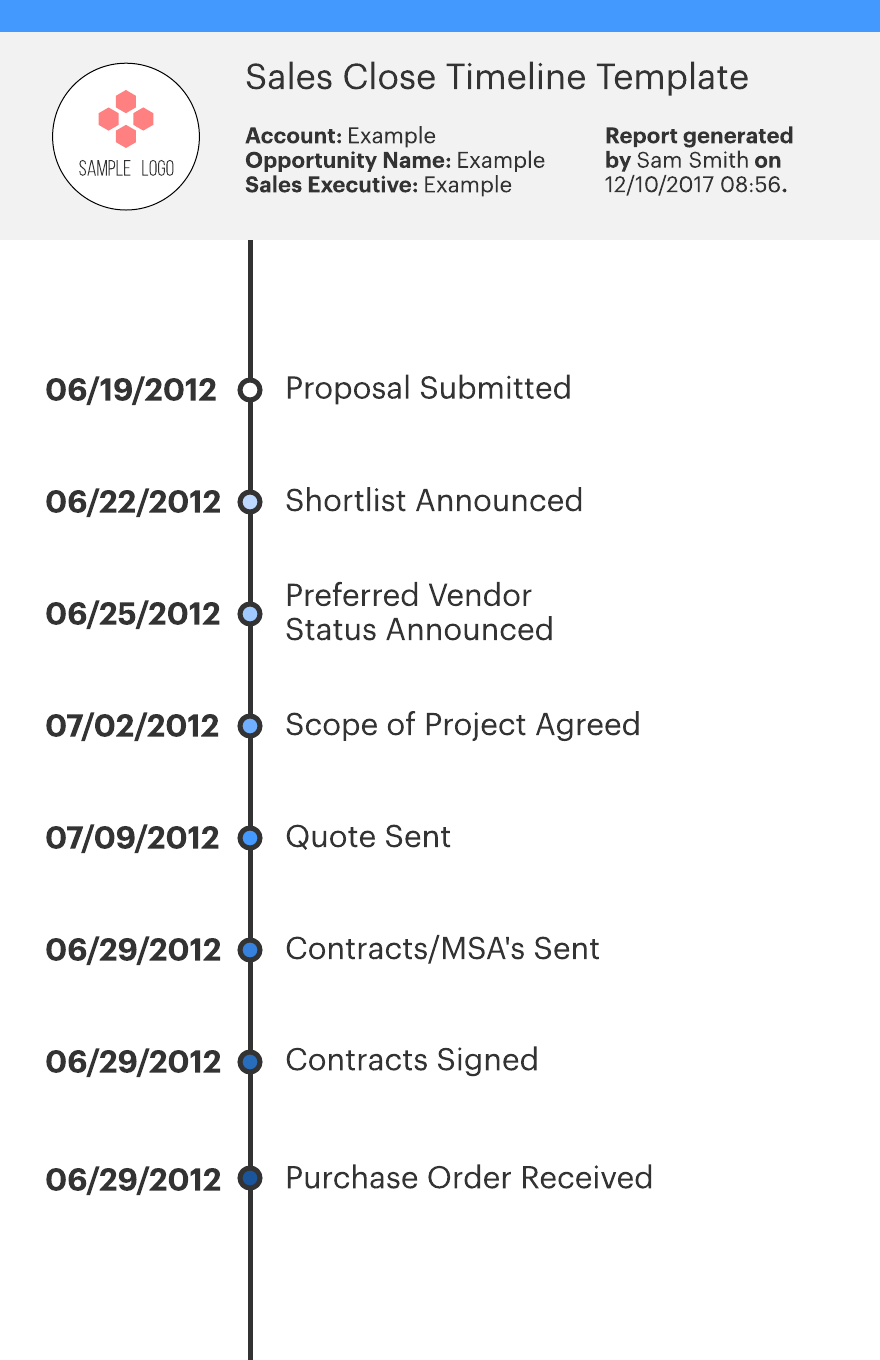Contrary to popular belief, when it comes to closing sales, it isn't about numbers—it's about people. The minute you take your focus off your customer and make it more about your numbers, your client will feel the shift.
Sales aren’t always smooth sailing, but by working visually, you can streamline your sales process and appear more focused, organized, and present for your client. Read on for some essential steps on how to close a sale and how Lucidchart can help with your closing ratio.
And as you approach the close, keep track of the major steps you should take, such as sending a proposal, getting a contract approved by the customer’s legal team, etc., with our sales close plan template. Lucidchart makes it easy to share important steps and dates with sales leadership and potential customers.

Step 1: Identify the decision-makers
Over 40% of sales reps say prospecting is the most difficult part of the sales process, and even the best sales pitch doesn't amount to much if you're not talking to the right people.
While it might feel like finding a needle in a giant corporate haystack, you can quickly identify the influencers within an organization by using an influencer map. Studies show that an average of seven people help make buying decisions in companies with 100-500 employees, and account maps can take the guesswork out of finding those people.
Pinpointing the right stakeholders in every sale is a crucial first step in closing sales: it saves you time, effort, and reputation. After all, the last thing any sales rep wants to be known for is blindly pitching to all the wrong people.

Step 2: Do your homework
Now that you know who the decision-makers are, it’s time to tailor your presentation to them. Research as much as you can about not only the pain points of their organization, but also about your competitors and why your product can serve your client’s needs better. This stage of planning also includes the minutia of forms, paperwork, and pricing so that you can go into your pitch fully prepared rather than frazzled.
Step 3: Pitch the solution you’re providing, not your product
Too often the sales pitch gets lost in translation among numbers, specs, and features. Move beyond the mere “what” of your product and help your client understand its “why”: why is this the solution for them? And why choose this solution over your competitors’?
By becoming skilled at translating features into customized benefits for your client, you’ll not only show the preparation you put into your pitch, but you will also show your customers that you’re anticipating their needs as well. Thoughtful presentation over an overly memorized, carbon-copy pitch will win out every time.
Step 4: Ask for the sale
Yes, really!
As silly as it sounds, some sales reps take the assumed close a little too far when they don’t directly ask for the sale. And while 61% of customers don’t want a pushy sales rep, being clear and concise in asking for the sale is anything but pushy.
Asking for the sale also gives you an opportunity to resolve concerns, should your customer waver or flat-out say no. Take the time to really listen. A scant 13% of customers think a sales rep really knows what they need; be the kind of sales rep to buck that trend.
If asking for the sale seems too aggressive at the moment, you should still ask the customer for next steps—and be prepared to suggest next steps (an onsite demo, a trial period, etc.) that will bring you closer to the sale.
Step 5: Anticipate and mitigate objections
Few sales are seamless as there are often objections, even small ones, that can crop up. But part of being prepared is anticipating possible obstacles to closing a sale and being attuned to concerns your client may have already shared with you. Consider creating an objections flowchart to help you navigate unknown variables by having a process in place to work through unexpected hurdles with your client.
Step 6: Create a sense of urgency
Do you have a prospect dragging their feet? Put a little pressure behind your pitch (although you should be careful of rushing the customer or getting too pushy). Whether you offer a limited-time discount or show your prospect how much time or money they are wasting without your product, you can motivate the customer to make a decision sooner.
Step 7: Don’t try so hard
While the cliché of ABC—or “always be closing”—may still be a rule of thumb for many salespeople, they may also forget what it feels like to be standing opposite of someone who is always (trying to) close. Exhausting, right? When you relax and spend time just being yourself instead of closing, authenticity shines through, and that’s what clients connect with.

Test your buyer experience during the closing phase to ensure your reps are doing everything possible to seal the deal.
Read nowAbout Lucidchart
Lucidchart, a cloud-based intelligent diagramming application, is a core component of Lucid Software's Visual Collaboration Suite. This intuitive, cloud-based solution empowers teams to collaborate in real-time to build flowcharts, mockups, UML diagrams, customer journey maps, and more. Lucidchart propels teams forward to build the future faster. Lucid is proud to serve top businesses around the world, including customers such as Google, GE, and NBC Universal, and 99% of the Fortune 500. Lucid partners with industry leaders, including Google, Atlassian, and Microsoft. Since its founding, Lucid has received numerous awards for its products, business, and workplace culture. For more information, visit lucidchart.com.

